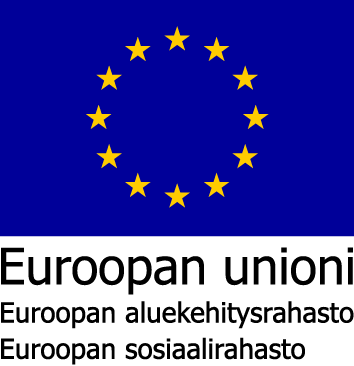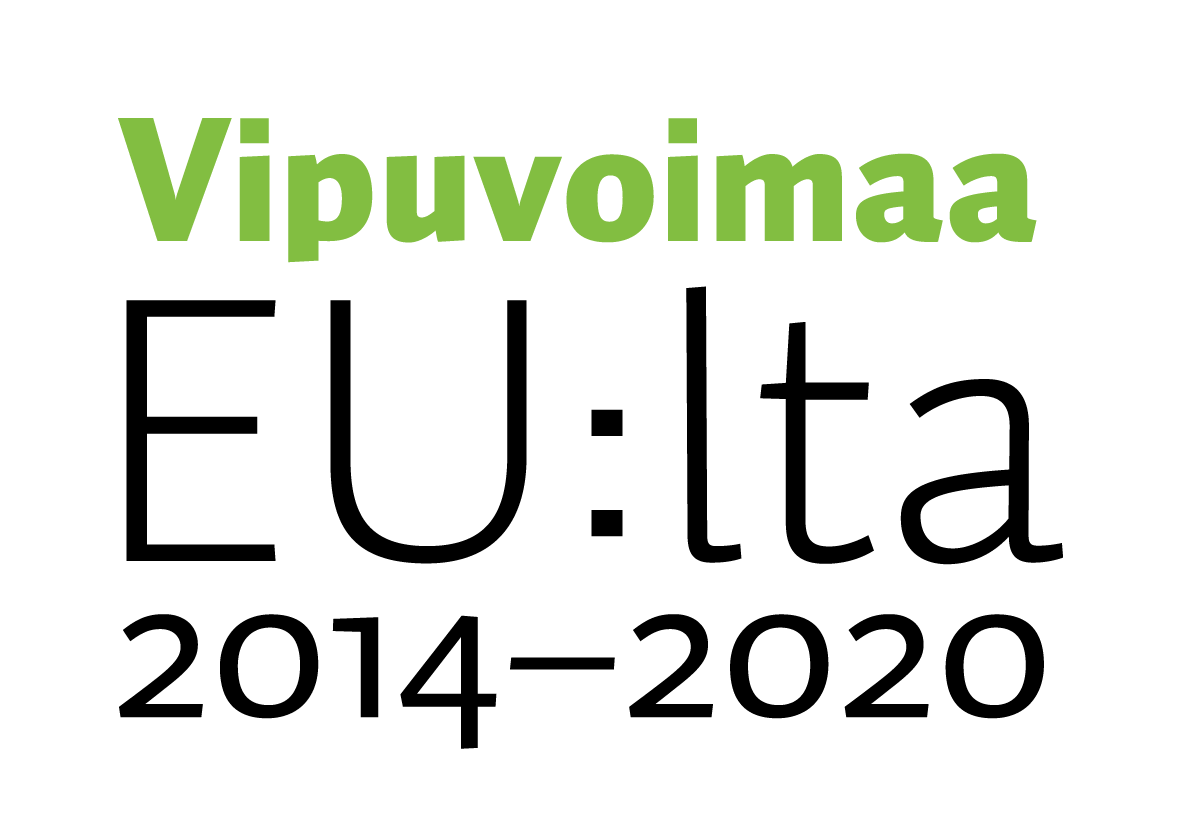

 |
 |
Hankekoodi: S21699
Hankkeen nimi: Ohjatusti kohti tulevaisuuden työelämää
Toimintalinja: 4. Koulutus, ammattitaito ja elinikäinen oppiminen
Erityistavoite: 9.1. Siirtymävaiheita ja koulutuksellista tasa-arvoa tukevien palveluiden parantaminen
Suunnitelman mukainen toteutusaika: Alkaa 1.8.2019 ja päättyy 28.2.2022
Toiminnan tila: Toiminta päättynyt
Vastuuviranomainen: Pohjois-Pohjanmaan elinkeino-, liikenne- ja ympäristökeskus
Hakijan virallinen nimi: Jyväskylän koulutuskuntayhtymä Gradia
Organisaatiotyyppi: Kuntayhtymä
Y-tunnus: 0208201-1
Jakeluosoite: PL 472
Puhelinnumero: 040 341 5111
Postinumero: 40101
Postitoimipaikka: Jyväskylä
WWW-osoite: http://www.gradia.fi
Hankkeen yhteyshenkilön nimi: Birgitta Mannila
Yhteyshenkilön asema hakijaorganisaatiossa: Projektipäällikkö
Yhteyshenkilön sähköpostisoite: birgitta.mannila(at)gradia.fi
Yhteyshenkilön puhelinnumero: 040 341 5594
Hakijoiden lukumäärä tai tuen siirto -menettely:
Työelämän murros ja muutos vaativat suomalaiselta koulujärjestelmältä uudistuvaa henkilökohtaista uraohjausta, työelämäorientaatiota ja oppimisen henkilökohtaistamista. Tämän muutoksen johdosta työura ei näyttäydy enää lineaarisena jatkumona, vaan vahvasti muuttuvana ja uusiutuvana. Lukion ja työelämän välistä suhdetta on siis kyettävä ajattelemaan uudella tavalla, joka sitoo uraohjauksen, oppiaineiden sisällöt, opettamisen ja opiskelijan henkilökohtaisen motivaation paremmin yhteen. Keskeisenä tarkoituksena on hahmottaa opiskelijan henkilökohtainen tulevaisuusorientaatio ja pohtia niitä keinoja, joilla koulu ja työelämä voivat tätä prosessia vahvistaa.
Hankkeessa keskitytään kolmeen eri työkokonaisuuteen, jotka ovat seuraavat:
• Uuden lukiolain luomien mahdollisuuksien hyödyntäminen työelämäyhteistyön kehittämisessä
• Työelämäyhteistyötä tukevien pedagogisten mallien sekä menetelmien kehittäminen
• Lukiolaisen motivaatioprofiili opinto-ohjauksen ja urasuunnittelun apuna
Tavoitteena on kehittää uudenlaisia työelämäyhteistyön malleja uuden lukiolain tavoitteiden mukaisesti ja opetussuunnitelman kehittämiseksi. Toisena tavoitteena on uudistaa lukiopedagogiikkaa tukemaan opiskelijoiden tulevaisuuden työelämätaitojen kehittymistä innovoimalla, pilotoimalla ja mallintamalla uusia integroituja oppiainerajat ylittäviä pedagogisia malleja. Näiden lisäksi hankkeessa on tavoitteena luoda toimintamalleja, joiden avulla nuoret löytävät heidän luontaisen motivaatioperustansa ja tekevät sitä kautta entistä henkilökohtaisempia opinto- ja työuravalintoja suhteessa ennakoituihin työelämätarpeisiin.
TOIMENPITEET
Hankkeen aikana järjestetään työpajoja lukioiden henkilöstölle ja alueen työ- ja yrityselämän edustajille sekä kartoitetaan uuden lukiolain mahdollisuuksia opintojen uudenlaiselle integroinnille. Hankkeessa luodaan opiskelijoille raamit ja työkaluja oman osaamisen löytämiseen, tunnistamiseen ja kehittämiseen. Hankkeessa kartoitetaan ja kehitetään erilaisia projektiviikon toimintamalleja yhteistyössä yritysten ja korkeakoulujen kanssa. Hankkeessa luodaan työelämälähtöisen alumnitoiminnan malli ja kartoitetaan erilaisia alustoja, joille opiskelijat voivat kirjata osaamistaan. Hankkeessa kehitetään ohjauksessa käytettäviä toimintamalleja ja niissä hyödynnettäviä työvälineitä. Ohjauksen työvälineenä ja motivaatioperusteisen pedagogiikan pohjana käytetään RSMP-motivaatioprofiilia. Hankkeessa ohjaushenkilöstöä perehdytetään motivaatioprofiilin laadinnan ohjaamiseen.
TULOKSET
Hankkeen toimenpiteiden kautta uusi lukiolaki ja uuden opetussuunnitelman muutokset saadaan näkyviksi ja täysimääräisesti hyödynnetyiksi lukioiden toiminnassa. Lisäksi lukion ja työelämän vuoropuhelu työelämän osaamistarpeista vahvistuu. Hankkeen toimintojen kautta saadaan käyttöön uusia projektiviikkojen ja työelämäyhteistyön malleja, jotka ovat myös valtakunnallisesti otettavissa käyttöön. Pitkän aikavälin tuloksina lukio-opiskelijoiden opinto- ja urapolut selkiytyvät ja valmistuvan opiskelijan osaaminen vastaa paremmin työelämän tarpeisiin. Opiskelijoiden kyvyt toimia tulevaisuuden muuttuvassa työelämässä vahvistuvat. Lukion opetussuunnitelma ja lukion pedagogiset menetelmät tukevat yhteiskunnan ja työelämän tarpeita.
Hanke on yhteishanke ja hankkeessa on mukana lukioita viidestä eri kunnasta. Hanketta hallinnoi Jyväskylän koulutuskuntayhtymä Gradia (Gradia-lukiot) ja osatoteuttajina ovat Kangasalan kaupunki (Kangasalan lukio), Kuopion kaupunki (Kuopion lukiot), Lempäälän kunta (Lempäälän lukio) ja Mikkelin kaupunki (Mikkelin lukio). Hanke toteutetaan tiiviissä yhteistyössä työelämän edustajien kanssa.
Hankkeen kohderyhminä ovat:
• lukioiden opiskelijat
• lukioiden opetus- ja ohjaushenkilöstö
Hankkeen välillisinä kohderyhminä ovat:
• hankkeen työpajatoimintaan osallistuvat yritys- ja työelämän edustajat, erityisesti lukiot omat alumnit
• hankkeen toteuttajien yhteistyökumppanit ml. kodit ja vanhemmat.
• oppilaitoskumppanit mm. Viisiapila-verkoston hankkeen ulkopuoliset jäsenet Hämeenlinna ja Lahti, korkeakoulukumppanit mm. Jyväskylän ammattikorkeakoulu, Jyväskylän yliopisto ja XAMK
• toiminta-alueen muut työ- ja yrityselämänkumppanit mm. yritykset, yrittäjät, kuntien ja valtion työnantajat
• kolmannen sektorin toimijat ja muut yhteistyökumppanit esim. Keski-Suomen Yrittäjät
Myönnetty EU- ja valtion rahoitus: 473 826
Toteutunut EU- ja valtion rahoitus: 439 607
Suunniteltu julkinen rahoitus yhteensä: 631 769
Toteutunut julkinen rahoitus yhteensä: 586 143
Hankkeen toiminta on valtakunnallista
Jakeluosoite:
Postinumero:
Postitoimipaikka:
Suunniteltu: 22
Toteutunut seurantatietojen mukaan: 13
Suunniteltu: 370
| Välitön | Välillinen | |
| Ekologinen kestävyys | ||
| Luonnonvarojen käytön kestävyys | 0 | 0 |
| Ilmastonmuutoksen aiheuttamien riskien vähentäminen | 0 | 0 |
| Kasvillisuus, eliöt ja luonnon monimuotoisuus | 0 | 0 |
| Pinta- ja pohjavedet, maaperä sekä ilma (ja kasvihuonekaasujen väheneminen) | 0 | 0 |
| Natura 2000 -ohjelman kohteet | 0 | 0 |
| Taloudellinen kestävyys | ||
| Materiaalit ja jätteet | 0 | 0 |
| Uusiutuvien energialähteiden käyttö | 0 | 0 |
| Paikallisen elinkeinorakenteen kestävä kehittäminen | 6 | 8 |
| Hankkeessa kehitettävällä työelämäyhteistyön mallilla on vaikutus elinkeinoelämän kehittämiseen. Hankkeen toimenpiteillä lisätään lukiolaisten työelämätaitoja ja saadaan lukion käyneet nuoret nopeammin työelämään. Lukioiden työelämäyhteystyön mallilla saadaan lukiokoulutusta työelämälähtöisemmäksi, laadukkaammaksi ja edistetään resurssien järkevää käyttöä. | ||
| Aineettomien tuotteiden ja palvelujen kehittäminen | 5 | 7 |
| Sujuvat opinto- ja työelämäpolut ovat tärkeitä paikallisesti, maakunnallisesti, valtakunnallisesti ja globaalisesti. Osaamisen kehittäminen on hankkeessa keskeistä. Hankkeessa kehitetään opetus- ja ohjaushenkilöstön työelämäosaamista ja tulevaisuusohjausta tukevaa pedagogiikkaa. Samalla syntyy vakiintuneita käytänteitä lukiokoulutukseen nuorten, henkilöstön ja työelämän yhteistyöhön. | ||
| Liikkuminen ja logistiikka | 2 | 1 |
| Hankkeen matkat sekä alueellisesti että valtakunnallisesti tehdään pääasiallisesti joukkoliikennettä käyttäen. Hankeverkoston välisessä yhteistyössä hyödynnetään mahdollisimman paljon sähköisiä menetelmiä, mm. kokouskäytänteissä. Kuitenkin vaikutukset liikkumiseen ja logistiikkaan ovat välillisiä. | ||
| Sosiaalinen ja kulttuurinen kestävyys sekä yhdenvertaisuus | ||
| Hyvinvoinnin edistäminen | 5 | 6 |
| Opiskelijoiden hyvinvointi kasvaa työelämäyhteistyön ja tulevaisuusajattelun lisääntyessä opinnoissa. Nuoret saavat laadukkaampaa ja yksilöllisempää mutta samalla myös monipuolisempaa uraohjausta, joka tukee nuorten hyvinvointia ja tulevaisuuden suunnittelua sekä ehkäisee opintojen keskeyttämistä ja syrjäytymistä. Nuorten työelämätaitojen parantuminen nopeuttaa koulutuspolkuja ja lisää heidän mahdollisuuksia työllistyä. | ||
| Tasa-arvon edistäminen | 4 | 6 |
| Hankkeella edistetään tasa-arvon toteutumista toisen asteen koulutuksessa työelämän näkökulmasta. Sukupuolten tasa-arvoa pyritään edistämään sekä sukupuolinäkökulman valtavirtaistamisella että erityistoimilla tasa-arvon esteiden poistamiseksi kuten uravalintoihin liittyvä ohjaus ja eri ammatteihin hakeutumisen tukeminen sukupuolesta riippumatta. | ||
| Yhteiskunnallinen ja kulttuurinen yhdenvertaisuus | 5 | 6 |
| Lukioiden henkilöstön työelämäosaamisen ja ohjaustaitojen kehittymisellä tuetaan eri sosioekonomisessa asemassa tai eri kulttuuristaustoista tulevien opiskelijoiden yhdenvertaista kohtelua ja ohjauksen toteutumista työelämään tai jatko-opintoihin siirryttäessä. Uraohjauksessa huomioidaan yksilön tarpeet ja nuorten uratoiveet. | ||
| Kulttuuriympäristö | 1 | 1 |
| Hankkeen toiminta lisää ja tukee yhteisöllisyyttä. Lukioiden henkilökunta ja opiskelijat osallistuvat yhdessä hankkeen eri vaiheisiin. Kuitenkin vaikutukset kulttuuriympäristöön ovat välillisiä. | ||
| Ympäristöosaaminen | 0 | 0 |
Hankkeessa kehitettiin uudenlaisia työelämäyhteistyön malleja uuden lukiolain tavoitteiden mukaisesti ja opetussuunnitelman kehittämiseksi sekä uudistettiin lukiopedagogiikkaa tukemaan opiskelijoiden tulevaisuuden työelämätaitojen kehittymistä innovoimalla, pilotoimalla ja mallintamalla uusia integroituja oppiainerajat ylittäviä pedagogisia malleja. Näiden lisäksi hankkeessa luotiin toimintamalleja, joiden avulla nuoret löytävät oman luontaisen motivaatioperustansa ja tekevät sitä kautta entistä henkilökohtaisempia opinto- ja työuravalintoja suhteessa ennakoituihin työelämätarpeisiin. Hankkeen toimenpiteiden kautta uusi lukiolaki ja uuden opetussuunnitelman muutokset saatiin näkyviksi ja hyödynnetyiksi lukioiden toiminnassa.
Hanke oli yhteishanke ja hankkeessa oli mukana lukioita viidestä eri kunnasta. Hanketta hallinnoi Jyväskylän koulutuskuntayhtymä Gradia (Gradia-lukiot) ja osatoteuttajina olivat Kangasalan kaupunki (Kangasalan lukio), Kuopion kaupunki (Kuopion lukiot), Lempäälän kunta (Lempäälän lukio) ja Mikkelin kaupunki (Mikkelin lukio).
Hankkeen aikana lukioissa järjestettiin työpajoja lukioiden henkilöstölle ja työ- ja yrityselämän edustajille. Työpajoissa pohdittiin uuden lukiolain velvoitteita lukioiden työelämäyhteistyölle käytännössä, tulevaisuuden työelämätaitoja ja yhteistyön merkitystä. Lukioissa työelämätietoisuuden vahvistamisen tavoitteet kirjattiin paikallisiin opetussuunnitelmiin ja esimerkiksi Gradia-lukioissa työelämä- ja yrittäjyysopinnot koottiin opetussuunnitelmaan omaksi kokonaisuudekseen.
Lukion ja työelämän vuoropuhelu työelämän osaamistarpeista vahvistui. Hankelukioissa tiivistettiin ja monipuolistettiin yritysten ja yhdistysten kanssa tehtävää yhteistyötä. Hankkeen aikana kartoitettiin uuden lukiolain mahdollisuuksia opintojen uudenlaiselle integroinnille ja työelämäyhteistyön malleille. Gradia-lukioissa pilotoitiin yhteistyöprojekteja yritysten kanssa ja oppiainerajat ylittäviä mini-integraatioita. Lempäälän lukiossa työelämätaidoista opiskelijoiden teknologiataidot ja erityisesti ohjelmointi olivat kehittämisen kohteena. Yhteistyö yritysten kanssa on ollut osa lukion Ilmastosoturitoimintaa. Mikkelin lukiossa toteutettiin työelämälähtöiset pedagogiset pakopelit. Kuopion ja Kangasalan lukioissa useamman oppiaineen integroinnit ovat osa tiimijakson toteutusta. Hankkeessa saatiin käyttöön yhdessä yritysten, työelämän toimijoiden ja korkeakoulujen kanssa rakennettuja uusia projektiviikon toimintamalleja. Gradia-lukioissa Innoviikolla ensimmäisen vuoden opiskelijat (n. 800) tutustuivat työelämään kahden päivän ajan ja ratkoivat kolme päivää tiimeissä yritysten antamia haasteita. Gradian lukioissa pilotoitiin opiskelijoiden virtuaalista työelämään tutustumista 17 yhteistyöorganisaation kanssa. Kuopion Klassillisessa lukiossa innovaatioviikko sisällytettiin tiimijaksoon. Kuopiossa lukioissa useamman vuoden käytössä ollutta tiimijaksoa kehitettiin edelleen. Kangasalan lukiossa tiimijakso toteutettiin ensimmäistä kertaa.
Hankkeessa edistettiin työelämälähtöisen alumnitoiminnan mallia. Jyväskylässä alumnitoimintaa rakennettiin Gradia-tasoisesti ja Kangasalan lukion alumnitoimintaa edistettiin mentorointipilotilla. Hankkeen aikana otettiin käyttöön Tiitus-pohjaiset sovellukset Gradia-lukioissa (Duuni Keski-Suomi) ja Kangasalan lukiossa (Jobba) ja sovellusta kokeiltiin myös Kuopiossa. Sovellukset toimivat verkossa ja opiskelijat voivat kirjata niihin osaamistaan helposti ja monipuolisesti. Kaikissa Kuopion lukioissa toteutettiin opettajien työelämään tutustuminen. Pienimuotoisemmin opettajien työelämään tutustumista järjestettiin Gradia-lukioissa ja Mikkelin lukiossa. Hankelukioiden opettajille järjestettiin työelämätaitoja ja ohjausosaamista vahvistavaa koulutusta, mm. tiimiosaamisen valmennusta, motivaatiokoulutusta ja koulutusta ryhmänohjaajuudesta. Hankkeessa toteutettiin viiden webinaarin sarja hankkeen keskeisistä teemoista.
Ohjauksen työvälineenä ja motivaatioperusteisen pedagogiikan pohjana käytettiin RSMP-motivaatioprofiilia. Ohjaushenkilöstöä perehdytettiin Reissin motivaatioteoriaan ja RSMP-motivaatioprofiilin käyttöön ohjauksen työvälineenä. Kuopion, Kangasalan ja Lempäälän lukioissa RSMP:n käyttöä laajennettiin ja syvennettiin. Gradia-lukioissa ja Mikkelin lukioissa pilotoitiin RSMP-työkalun käyttöä ja hyödynnettiin muilla hankeverkoston jäsenillä jo olemassa olevaa tietoa sen tarjoamista mahdollisuuksista. Opinto-ohjaajia koulutettiin RSMP-koulumotivaatiovalmentajiksi ja he teettivät motivaatioprofiileja yhteensä sadoille opiskelijoille. Lukuisa joukko lukioiden opettajia sai oman RMP-profiilin ja pääsi osallistumaan koulutukseen motivaatioprofiilin pedagogisesta hyödyntämisestä.